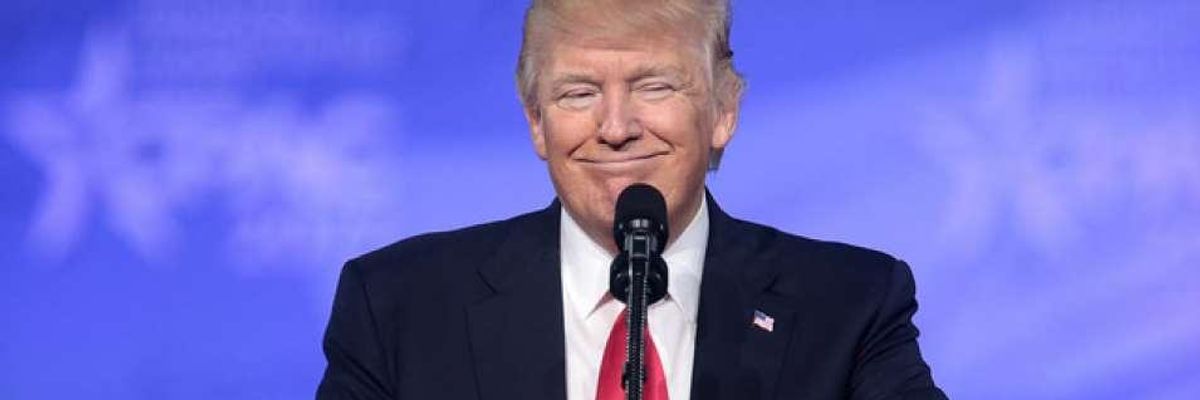President Trump inherited several positive economic trends, and no one should be surprised that he's taking credit for them.
This is White House Economics 101: Though it is almost always undeserved, presidents take credit for good economies and try to blame others for bad ones. Putting that truism aside, let's get under the economic hood and look at how great the U.S. economy really is right now. As always in expansions, there are strong spots and weak points.
Strength No. 1 is the job market, specifically the increase in jobs and the commensurate decline in unemployment. That Trump inherited this trend is beyond question. I extrapolated the trend in unemployment from its peak in early 2010 to the end of 2016, and then kept that same linear trend going through January 2017, when Trump took office, until now. The result is a jobless rate of 3.6 percent, almost exactly the current rate (3.8). Same for African Americans.

The same exercise with average monthly job growth reveals a slight deceleration, from about 200,000 per month to 190,000 since Trump took office. To be clear, that difference is both insignificant and expected: As we close in on full employment, job growth will tend to decelerate.

So, team Trump has every right to tout these trends, but there's not a shred of evidence they have contributed to them. Still, they haven't messed them up . . . yet.
They can legitimately take credit for juicing GDP growth, which has accelerated due to the deficit-financed fiscal stimulus from the tax cuts and spending. Economists not in employ of the administration believe this sugar high will fade by around 2020, but for now, they have done something highly unusual: aggressively stimulate an economy that was heading toward full employment on its own.
Despite this added GDP growth, there are three ways today's economy is significantly underperforming: wage growth, productivity growth and the fiscal outlook.
Given the tightness of the labor market, we should be seeing faster wage growth, and its absence is inconsistent with all that "best ever" stuff. The fundamental building block for middle-class living standards is the real (i.e., inflation adjusted) hourly pay of mid-wage workers, which has gone up only 0.6 percent per year since Trump took office.
In the full-employment latter 1990s, this working-class real wage grew at an annual rate of 1.4 percent, more than twice the rate it's growing today. The job market was tighter back then: The unemployment rate was also around 4 percent but there were fewer working-age folks on the sidelines. So, one explanation for Trump's wage problem is that there is more slack in the job market than that 3.8 percent unemployment rate suggests.
Another explanation for slow real wage growth is something most economists agree is the most serious shortcoming in today's economy: slow productivity growth. The figure below shows that the growth of output-per-hour worked is creeping along at its lowest growth rate in decades.

Slow output-per-hour is typically cited as a constraint on trend GDP growth (as noted, their stimulus is, for the time being, counteracting that effect). But slow productivity growth is also a constraint on wages, making it harder for firms to both maintain profitability and boost worker pay. So, they are choosing profits over pay hikes, and given workers' weak bargaining clout, they have been getting away with it.
Lastly, there's the deteriorating fiscal outlook, which, of course, has Trump and the Republicans' fingerprints all over it. My main fiscal concerns stem from the devious play by Republicans to cut taxes for their donor base and then whine about how we just can't afford Social Security and Medicare. But the near-term economic impact of this play is also worth noting.
To finance the extra debt, the Treasury must significantly increase the supply of bonds, which lowers their price and raises their yields. Meanwhile, the Federal Reserve, worried about potential overheating, is also raising rates. Higher interest rates put upward pressure on debt service, and not just for the federal government but for the highly leveraged corporate sector. Of course, rates have been so low for so long that they have room to grow, but the transition to the higher rate regime is a risk factor.
Which serves as a reminder of another big risk in the economy. Somewhere out there, no one knows where, lurks the next recession. It is here where presidents make a big economic difference, and the thought of this administration and Congress having to quickly react to an economic downturn is a very scary one.
Depending on when the downturn hits, even with its recent rate hikes, the Fed may not have a lot of interest-rate firepower. Also, as of the late 2017, more than half the states' unemployment insurance trust funds failed to meet the Labor Department's minimum standard for recession readiness (11 of these states had less than half the recommended savings; California's system is in particularly bad shape). Put it all together, and you'll understand why recession-unpreparedness (and binge-watching the brilliant series "Deadwood") keeps me up nights.
So, while I don't begrudge team Trump their bragging -- it's standard practice -- if anything, the strength of the economy underscores how little it has to do with this extremely chaotic presidency and an economic team that engages far more in wishful thinking than cogent analysis.
Thus far, the U.S. economy has been Trump-proof. But that could change, and when it does, the economic cost of his presidency could quickly become clear.



